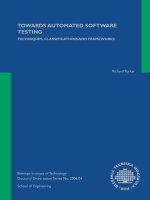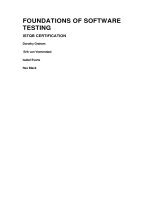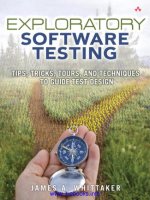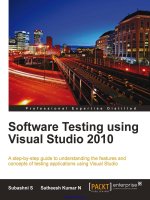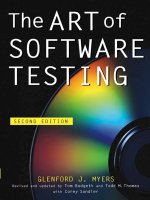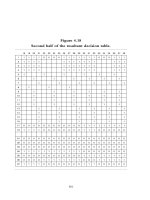software testing Static testing
Bạn đang xem bản rút gọn của tài liệu. Xem và tải ngay bản đầy đủ của tài liệu tại đây (736.61 KB, 43 trang )
SOFTWARE TESTING
PART III
STATIC TESTING
Contents
Overview test techniques
Types of review (Review analysis)
Static analysis
Overview test techniques
A test design techniques
help us to select a good
set of test from the total
number of all possible
test for a given system.
There are two main
categories of Test Design
Techniques:
+ Static techniques
+ Dynamic Techniques
Control
flow
Data
flow
Static testing vs Dynamic testing
Static testing vs Dynamic testing
Benefits of reviews
Development productivity improvement
Reduced development timescales
Reduced testing time and cost
Lifetime cost reductions
Reduced fault levels
Improved customer relations
etc.
Reviews are cost-effective
10 times reduction in faults reaching test, testing cost
reduced by 50% to 80%
Handbook of Walkthroughs, Inspections & Technical Reviews Freedman & Weinberg
What can be inspected
Anything that is written or typed
What can be tested by static testing:
policy, strategy, business plans, marketing or advertising
material, contracts
system requirements, feasibility studies, acceptance test plans
test plans, test designs, test cases, test results
schedules
system designs, logical & physical
software code
user manuals, procedures, training material
Goals of static testing
Deviations from standards
Requirements defects
Design Defects
Insufficient maintainability
Incorrect interface specifications
Costs of reviews
Rough guide: 5%-15% of development effort
Effort required for reviews
planning (by leader / moderator)
preparation / self-study checking
meeting
fixing / editing / follow-up
recording & analysis of statistics / metrics
process improvement (should!)
Type of reviews
1. Review process (normal)
2. Informal review
3. Inspection
4. Technical review
5. Walkthrough
Reviews
A review is any activity in which a work product is
distributed to reviewers who examine it and give feedback
And we have many types of review
Review process
Activities of a formal Review
+ Planning
- Defining the review criteria.
- Selecting the personnel.
- Allocating Roles
+ Overview (kick-off)
- Distributing documents
- Explaining the objectives, process and document to the participants.
+ Preparation
. Individual reviewing the documents
. Noting defects, question, comments
+ Review Meeting (examination)
. Discussing or logging, with documented results
+ Re-work
.Fixing defects found and update status of defects
+ Follow-up
. Checking that defects have been addressed.
. Gathering metrics (time, count defect,...)
. Checking on exit criteria.
Role and responsibilities
Review Roles
+ Manager
Decides on what is to be reviewed, schedule, closure.
+ Moderator
Planning the review, moderate review meeting and follow up
after meeting.
+ Author
Takes responsibility for fixing any agreed defects.
+ Reviewer (Inspector)
Identify and describes defect (with solutions)
+ Recorder (scriber)
attends the review meeting and documents all of the issues and
defects, problems and open points.
Informal Review
No formal process
Example: Pair programming, A technical lead reviewing design
and code.
Result should not be explicitly documented – a list of remarks or
revised document is enough.
Very common review type. Take little effort.
Inexpensive way to get some benefit.
Walkthrough review
Author presents the document to stakeholder both within
and outside the software discipline, in order to gather
information regarding the topic under documentation.
To explain (knowledge transfer) and evaluate the contents
of the document.
To establish a common understanding of the document.
To examine and discuss the validity of proposed solution.
Suitable for small teams (<=10 members). Can be used for
checking “non-critical“ document.
Inspection review
Is a moderated meeting in which reviewer list all issues and
defects they have found in the document and log them so
that they can be addressed by author.
Commonly inspected work products such as SRS, design
document, test plans.
Inspection, how do:
A work product and an inspection team is selected.
A moderator is chosen to moderate the meeting.
Each inspector prepares for the meeting by reading the
work product and noting each defect.
Meeting: discussion is focused on each defect, and
coming up with a specific resolution.
The moderator complies all of the defect resolutions into a
inspection log.
Inspection Process
planning
Kickoff
Preparation
Review
meeting
Rework
Work product and inspection team is selected
Moderator (inspection leader) is chosen
Define entry and exit criteria.
Decide which part of work product to review
Assign the roles to the reviewers.
Follow up
Inspection process
planning
Kickoff
Preparation
Review
meeting
Rework
Follow up
Distributing documents
Explaining the objectives, process, and documents.
Checking entry criteria
Note: role assignments, checking rate, the pages to be
checked.
Inspection process
planning
Kickoff
Preparation
Review
meeting
Rework
Follow up
The participants work individually on the
work product under review.
Can use the related documents, rules
and checklists provided
Time
Identify defects, questions and
comments and write a report for them.
Note: Should use checklists.
checking
rate
size
Inspection progress
planning
Kickoff
Preparation
Review
meeting
Rework
Follow up
The meeting typical consist of: logging, discussion and
decision phase.
the meeting is moderated by moderator (inspection
leader)
During the logging phase the issues are mentioned page
by page, reviewer by reviewer and should not discuss.
in discussion phase, focused on issues, and classify them
(critical, major, minor)
At the end of the meeting, a decision on the work product
under review has to be made by the participants
Inspection process
planning
Kickoff
Preparation
Review
meeting
Rework
Follow up
Based on the defects detected, the author will
improve the work product under review step by step.
Changes that are made to the document should be
easy to identify during follow up.
Inspection process
planning
Kickoff
Preparation
Review
meeting
Rework
Follow up
The moderator will check that the agreed defects
have been addressed.
And will gather metrics such as how time was spent on
the review, how many defects were found.
Will also check the exit criteria to ensure that they
have been met.
Technical Review
Is a discussion meeting that focuses on achieving
consensus about the technical content.
The experts that are needed for a technical review.
+ Architects
+ Chief designers
+ Key users

